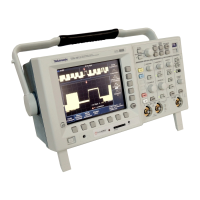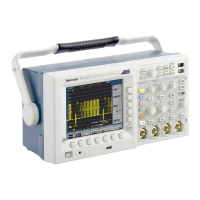Appendix A: Specifications
Trigger
State
Pattern Pattern with pulse width
4ns
2
2ns
5ns
Logic
Triggering
Minimum
Rearm Time,
typical
State minimum rearm time: the time between consecutive clocks. Pattern
minimum rear
m time: the time that a logic pattern must be invalid before a
new occurrence of the pattern will be recognized. Pattern with pulse width
qualification, minimum rearm time: the time that a logic pattern must be
invalid bef
ore a new occurrence of the pattern will be recognized.
Pulse
Triggering
Minimum Pulse
Width, typical
5ns
For w idth and runt, minimum pulse width refers to the pulse being
measured.
For slew rate, minimum pulse width means the minimum delta
time that the oscilloscope recognizes.
Pulse
Triggering
Minimum
Rearm Tim
e,
typical
5ns
For width
and runt, rearm time refers to the time between measured
pulses. For slew rate, rearm time refers to the time it takes the signal to
recross the two signal thresholds.
Time Ran
ge
Resolut
ion
39.6nsto9.99μs 13.2 ns
10 μsto99.9μs 92.4 ns
100 μst
o 999 μs
1 μs
1msto9.99ms 10μs
10 ms to 99.9 ms 100 μs
100 ms
to 999 ms
1ms
Delta Ti
me
Resolution
using general
purpose
knob
1sto10s 10ms
Triggers on negative sync of NTSC, PAL, or SECAM signal
Source Sensitivity
Any channel
0.6 to 2.5 divisions of video sync
tip
External trigger
15
0 m V to 625 mV of video sync
tip
Video trigger
sensitivity,
typi
cal
External/10 trigger 1.5 V to 6.25 V of video sync tip
B
Trigger
Trigger After Time Trigger After B E vents
R
ange
1
3.2nsto50s
1
event to 9,999,999 events
Minimum time
between arm
and trigger,
typical
5 ns from the end of the time period
and the B trigger event
5 ns between the A trigger event
and the first B trigger event
TDS3000C Series Oscilloscope User Manual 127

